park assist PONTIAC GRAND PRIX 2008 Owners Manual
[x] Cancel search | Manufacturer: PONTIAC, Model Year: 2008, Model line: GRAND PRIX, Model: PONTIAC GRAND PRIX 2008Pages: 450, PDF Size: 2.64 MB
Page 84 of 450
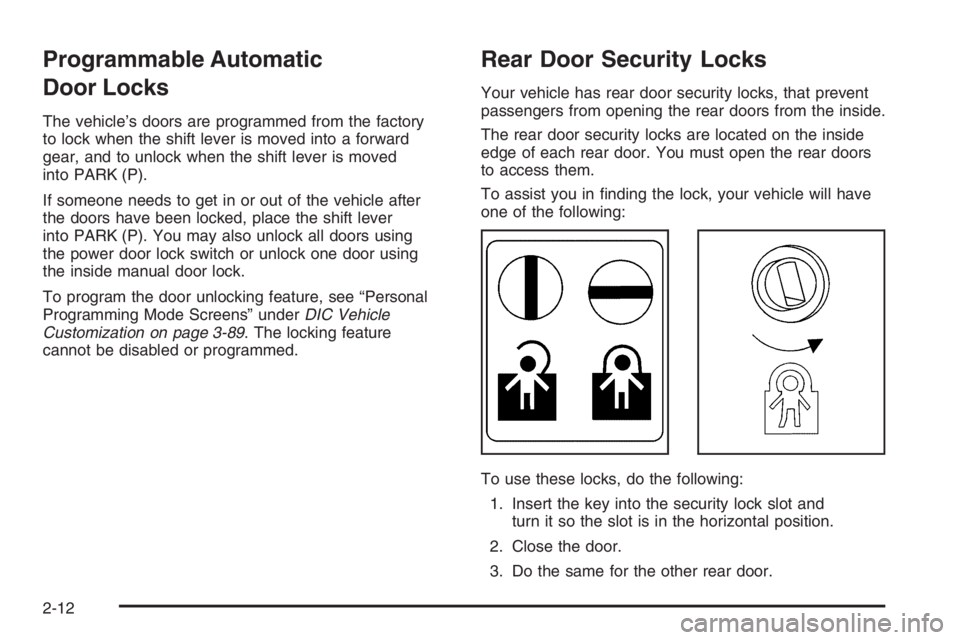
Programmable Automatic
Door Locks
The vehicle’s doors are programmed from the factory
to lock when the shift lever is moved into a forward
gear, and to unlock when the shift lever is moved
into PARK (P).
If someone needs to get in or out of the vehicle after
the doors have been locked, place the shift lever
into PARK (P). You may also unlock all doors using
the power door lock switch or unlock one door using
the inside manual door lock.
To program the door unlocking feature, see “Personal
Programming Mode Screens” underDIC Vehicle
Customization on page 3-89. The locking feature
cannot be disabled or programmed.
Rear Door Security Locks
Your vehicle has rear door security locks, that prevent
passengers from opening the rear doors from the inside.
The rear door security locks are located on the inside
edge of each rear door. You must open the rear doors
to access them.
To assist you in �nding the lock, your vehicle will have
one of the following:
To use these locks, do the following:
1. Insert the key into the security lock slot and
turn it so the slot is in the horizontal position.
2. Close the door.
3. Do the same for the other rear door.
2-12
Page 97 of 450
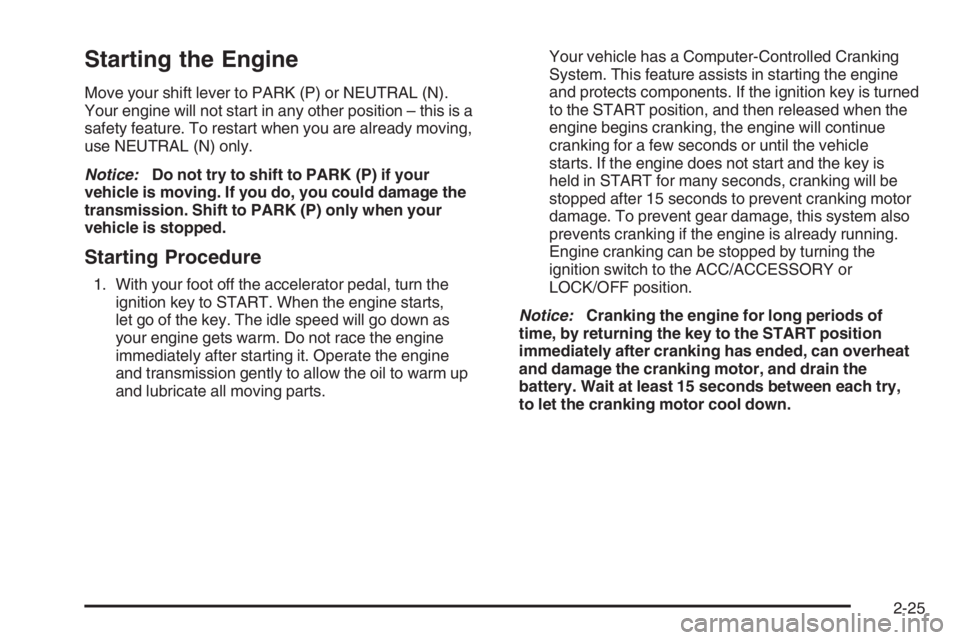
Starting the Engine
Move your shift lever to PARK (P) or NEUTRAL (N).
Your engine will not start in any other position – this is a
safety feature. To restart when you are already moving,
use NEUTRAL (N) only.
Notice:Do not try to shift to PARK (P) if your
vehicle is moving. If you do, you could damage the
transmission. Shift to PARK (P) only when your
vehicle is stopped.
Starting Procedure
1. With your foot off the accelerator pedal, turn the
ignition key to START. When the engine starts,
let go of the key. The idle speed will go down as
your engine gets warm. Do not race the engine
immediately after starting it. Operate the engine
and transmission gently to allow the oil to warm up
and lubricate all moving parts.Your vehicle has a Computer-Controlled Cranking
System. This feature assists in starting the engine
and protects components. If the ignition key is turned
to the START position, and then released when the
engine begins cranking, the engine will continue
cranking for a few seconds or until the vehicle
starts. If the engine does not start and the key is
held in START for many seconds, cranking will be
stopped after 15 seconds to prevent cranking motor
damage. To prevent gear damage, this system also
prevents cranking if the engine is already running.
Engine cranking can be stopped by turning the
ignition switch to the ACC/ACCESSORY or
LOCK/OFF position.
Notice:Cranking the engine for long periods of
time, by returning the key to the START position
immediately after cranking has ended, can overheat
and damage the cranking motor, and drain the
battery. Wait at least 15 seconds between each try,
to let the cranking motor cool down.
2-25
Page 244 of 450
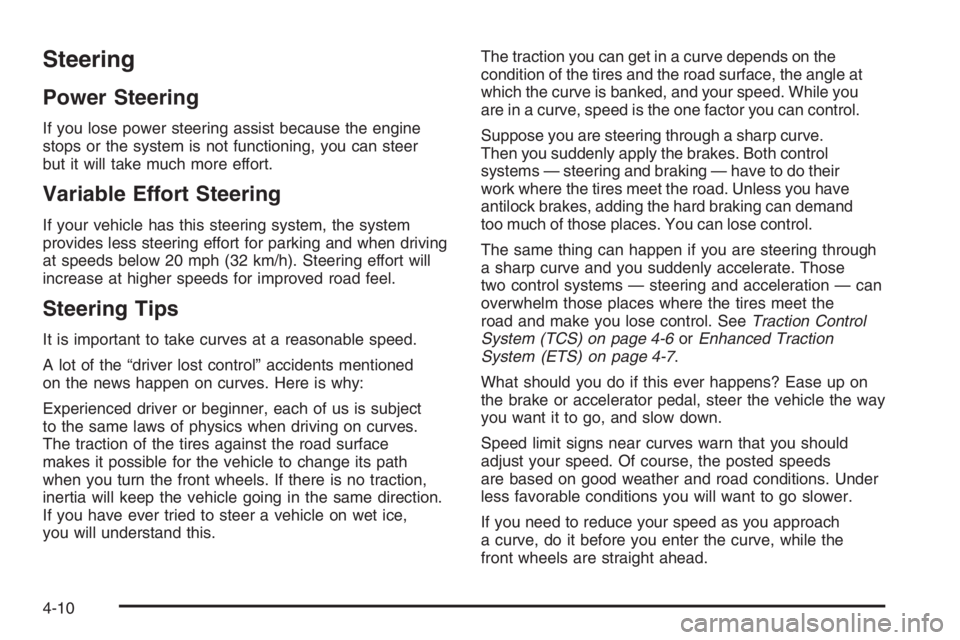
Steering
Power Steering
If you lose power steering assist because the engine
stops or the system is not functioning, you can steer
but it will take much more effort.
Variable Effort Steering
If your vehicle has this steering system, the system
provides less steering effort for parking and when driving
at speeds below 20 mph (32 km/h). Steering effort will
increase at higher speeds for improved road feel.
Steering Tips
It is important to take curves at a reasonable speed.
A lot of the “driver lost control” accidents mentioned
on the news happen on curves. Here is why:
Experienced driver or beginner, each of us is subject
to the same laws of physics when driving on curves.
The traction of the tires against the road surface
makes it possible for the vehicle to change its path
when you turn the front wheels. If there is no traction,
inertia will keep the vehicle going in the same direction.
If you have ever tried to steer a vehicle on wet ice,
you will understand this.The traction you can get in a curve depends on the
condition of the tires and the road surface, the angle at
which the curve is banked, and your speed. While you
are in a curve, speed is the one factor you can control.
Suppose you are steering through a sharp curve.
Then you suddenly apply the brakes. Both control
systems — steering and braking — have to do their
work where the tires meet the road. Unless you have
antilock brakes, adding the hard braking can demand
too much of those places. You can lose control.
The same thing can happen if you are steering through
a sharp curve and you suddenly accelerate. Those
two control systems — steering and acceleration — can
overwhelm those places where the tires meet the
road and make you lose control. SeeTraction Control
System (TCS) on page 4-6orEnhanced Traction
System (ETS) on page 4-7.
What should you do if this ever happens? Ease up on
the brake or accelerator pedal, steer the vehicle the way
you want it to go, and slow down.
Speed limit signs near curves warn that you should
adjust your speed. Of course, the posted speeds
are based on good weather and road conditions. Under
less favorable conditions you will want to go slower.
If you need to reduce your speed as you approach
a curve, do it before you enter the curve, while the
front wheels are straight ahead.
4-10
Page 250 of 450
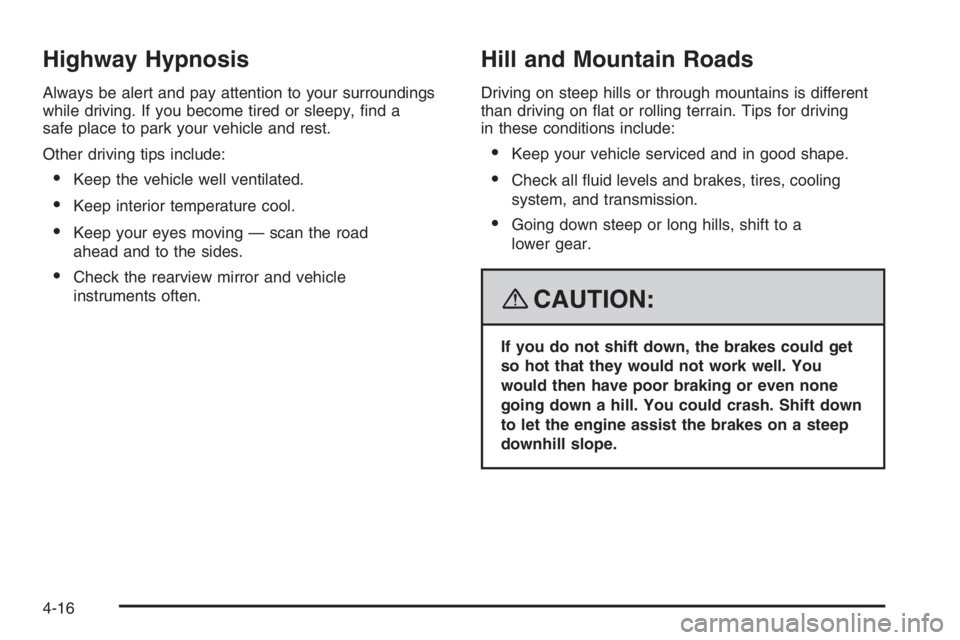
Highway Hypnosis
Always be alert and pay attention to your surroundings
while driving. If you become tired or sleepy, �nd a
safe place to park your vehicle and rest.
Other driving tips include:
Keep the vehicle well ventilated.
Keep interior temperature cool.
Keep your eyes moving — scan the road
ahead and to the sides.
Check the rearview mirror and vehicle
instruments often.
Hill and Mountain Roads
Driving on steep hills or through mountains is different
than driving on �at or rolling terrain. Tips for driving
in these conditions include:
Keep your vehicle serviced and in good shape.
Check all �uid levels and brakes, tires, cooling
system, and transmission.
Going down steep or long hills, shift to a
lower gear.
{CAUTION:
If you do not shift down, the brakes could get
so hot that they would not work well. You
would then have poor braking or even none
going down a hill. You could crash. Shift down
to let the engine assist the brakes on a steep
downhill slope.
4-16
Page 356 of 450
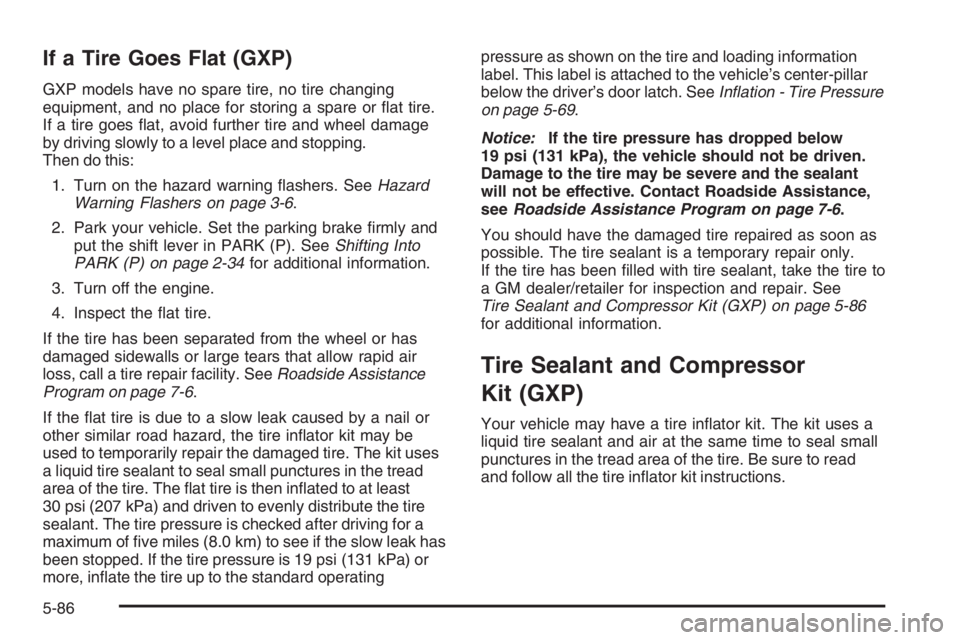
If a Tire Goes Flat (GXP)
GXP models have no spare tire, no tire changing
equipment, and no place for storing a spare or �at tire.
If a tire goes �at, avoid further tire and wheel damage
by driving slowly to a level place and stopping.
Then do this:
1. Turn on the hazard warning �ashers. SeeHazard
Warning Flashers on page 3-6.
2. Park your vehicle. Set the parking brake �rmly and
put the shift lever in PARK (P). SeeShifting Into
PARK (P) on page 2-34for additional information.
3. Turn off the engine.
4. Inspect the �at tire.
If the tire has been separated from the wheel or has
damaged sidewalls or large tears that allow rapid air
loss, call a tire repair facility. SeeRoadside Assistance
Program on page 7-6.
If the �at tire is due to a slow leak caused by a nail or
other similar road hazard, the tire in�ator kit may be
used to temporarily repair the damaged tire. The kit uses
a liquid tire sealant to seal small punctures in the tread
area of the tire. The �at tire is then in�ated to at least
30 psi (207 kPa) and driven to evenly distribute the tire
sealant. The tire pressure is checked after driving for a
maximum of �ve miles (8.0 km) to see if the slow leak has
been stopped. If the tire pressure is 19 psi (131 kPa) or
more, in�ate the tire up to the standard operatingpressure as shown on the tire and loading information
label. This label is attached to the vehicle’s center-pillar
below the driver’s door latch. SeeInflation - Tire Pressure
on page 5-69.
Notice:If the tire pressure has dropped below
19 psi (131 kPa), the vehicle should not be driven.
Damage to the tire may be severe and the sealant
will not be effective. Contact Roadside Assistance,
seeRoadside Assistance Program on page 7-6.
You should have the damaged tire repaired as soon as
possible. The tire sealant is a temporary repair only.
If the tire has been �lled with tire sealant, take the tire to
a GM dealer/retailer for inspection and repair. See
Tire Sealant and Compressor Kit (GXP) on page 5-86
for additional information.
Tire Sealant and Compressor
Kit (GXP)
Your vehicle may have a tire in�ator kit. The kit uses a
liquid tire sealant and air at the same time to seal small
punctures in the tread area of the tire. Be sure to read
and follow all the tire in�ator kit instructions.
5-86
Page 367 of 450
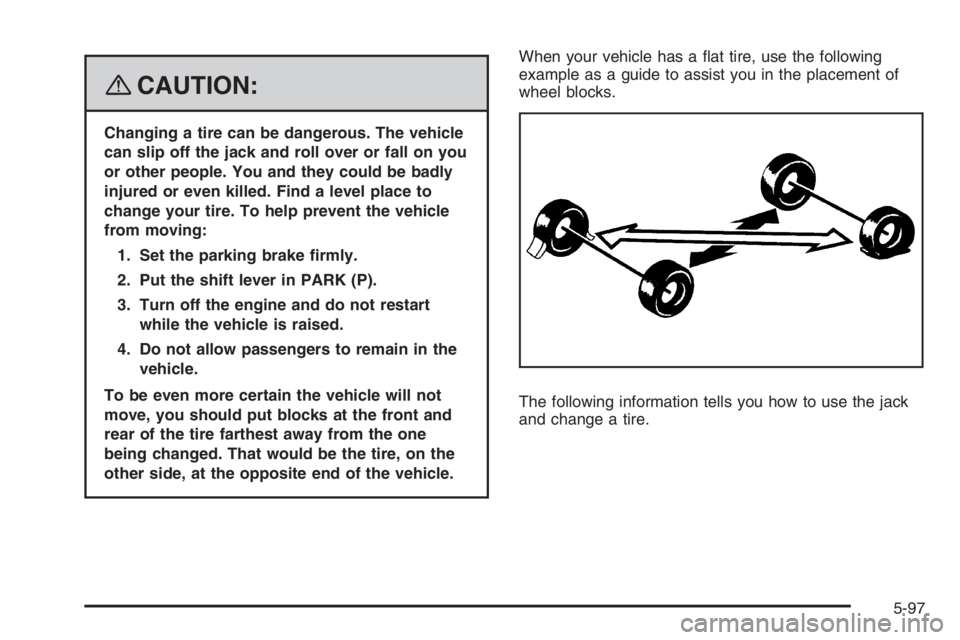
{CAUTION:
Changing a tire can be dangerous. The vehicle
can slip off the jack and roll over or fall on you
or other people. You and they could be badly
injured or even killed. Find a level place to
change your tire. To help prevent the vehicle
from moving:
1. Set the parking brake �rmly.
2. Put the shift lever in PARK (P).
3. Turn off the engine and do not restart
while the vehicle is raised.
4. Do not allow passengers to remain in the
vehicle.
To be even more certain the vehicle will not
move, you should put blocks at the front and
rear of the tire farthest away from the one
being changed. That would be the tire, on the
other side, at the opposite end of the vehicle.When your vehicle has a �at tire, use the following
example as a guide to assist you in the placement of
wheel blocks.
The following information tells you how to use the jack
and change a tire.
5-97
Page 446 of 450
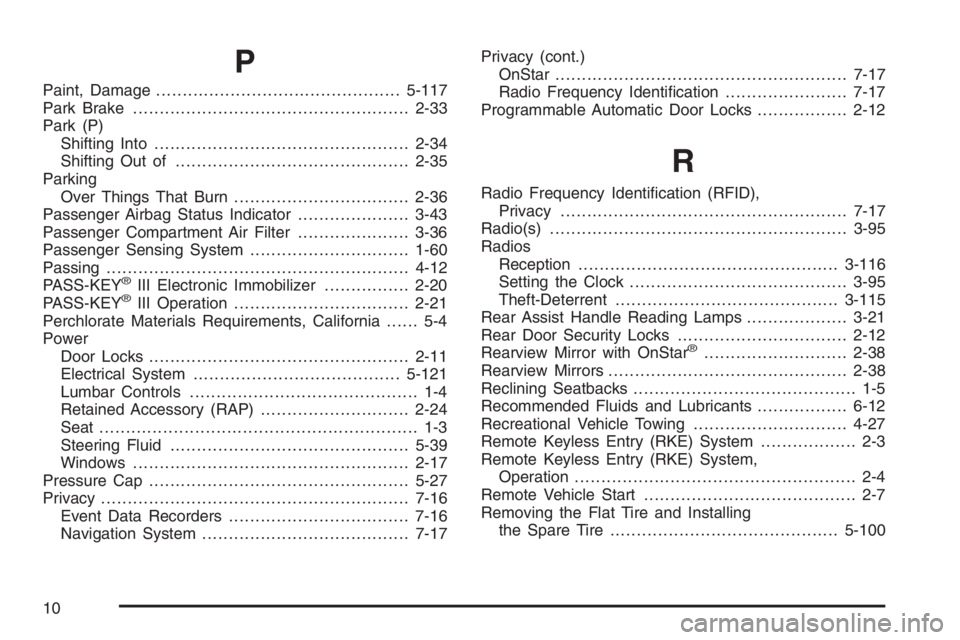
P
Paint, Damage..............................................5-117
Park Brake....................................................2-33
Park (P)
Shifting Into................................................2-34
Shifting Out of............................................2-35
Parking
Over Things That Burn.................................2-36
Passenger Airbag Status Indicator.....................3-43
Passenger Compartment Air Filter.....................3-36
Passenger Sensing System..............................1-60
Passing.........................................................4-12
PASS-KEY
®III Electronic Immobilizer................2-20
PASS-KEY®III Operation.................................2-21
Perchlorate Materials Requirements, California...... 5-4
Power
Door Locks.................................................2-11
Electrical System.......................................5-121
Lumbar Controls........................................... 1-4
Retained Accessory (RAP)............................2-24
Seat ............................................................ 1-3
Steering Fluid.............................................5-39
Windows....................................................2-17
Pressure Cap.................................................5-27
Privacy..........................................................7-16
Event Data Recorders..................................7-16
Navigation System.......................................7-17Privacy (cont.)
OnStar.......................................................7-17
Radio Frequency Identi�cation.......................7-17
Programmable Automatic Door Locks.................2-12
R
Radio Frequency Identi�cation (RFID),
Privacy......................................................7-17
Radio(s)........................................................3-95
Radios
Reception.................................................3-116
Setting the Clock.........................................3-95
Theft-Deterrent..........................................3-115
Rear Assist Handle Reading Lamps...................3-21
Rear Door Security Locks................................2-12
Rearview Mirror with OnStar
®...........................2-38
Rearview Mirrors.............................................2-38
Reclining Seatbacks.......................................... 1-5
Recommended Fluids and Lubricants.................6-12
Recreational Vehicle Towing.............................4-27
Remote Keyless Entry (RKE) System.................. 2-3
Remote Keyless Entry (RKE) System,
Operation..................................................... 2-4
Remote Vehicle Start........................................ 2-7
Removing the Flat Tire and Installing
the Spare Tire...........................................5-100
10